Phillip Gales:
Good morning, everyone. I'm very excited to be talking to Scott Vincent from COMRC.org.
Scott, can you start by telling us what COMRC stands for, what you're doing, and why you started?
Scott Vincent:
Sure. So COMRC stands for the Critical Ocean Minerals Research Center. This is a website that we set up to inform the public about the nascent industry of polymetallic nodule harvesting. We go through the costs and the benefits of nodule harvesting, we try to make the science that's being done in the industry available to the public, and we write blog posts about industry developments.
A big part of the website is actually dedicated to dispelling the myths that have been created around the deep-sea mining industry by those who are opposing it, namely, environmental groups who don't want to see the industry start. They will say what they need to to keep it from starting, and oftentimes they don't have a whole lot of regard for accuracy.

Phillip Gales:
I'm sure we're all aware of the big debate around deep sea mining, and particularly this opportunity to source critical minerals which we need for the green energy transition. How do you think about that debate around the need for critical minerals, and the opportunity in deep sea mining?
Scott Vincent:
Yeah, that's an interesting question. I think that the opponents of this practice have created this straw man argument that we don't need minerals from the bottom of the ocean to enable the energy transition - so therefore we shouldn't extract them.
We actually, take the point of view that we need these minerals from the bottom of the ocean, whether or not that transition happens. We need them because we do a lot less damage to humanity and to the environment when we extract minerals from the bottom of the ocean versus when we take them from terrestrial locations. I think that decarbonization is going to happen. I think the energy transition is going to happen. I think it will happen with much more force and speed if we tap these resources. But whether or not we absolutely need to tap these resources for decarbonization is a debatable point.
"we need these minerals from the bottom of the ocean, whether or not (the green energy) transition happens"
Phillip Gales:
That's an interesting one. So what you're saying is that Supporters of deep sea mining are saying, “the green energy transition can go faster with this”, while Opponents are saying, “we don't need it”. But your point is, “hey, everyone, we desperately need these critical minerals anyway. This is just a better way of doing it.”
Scott Vincent:
Yeah, we're going to need to continue mining for critical minerals regardless in the future, whether decarbonization happens or not. Anyone who tells you that recycling, reuse and innovation will somehow do away with the need for mining isn't facing reality, right? They're not looking at the actual numbers. They're not listening to the analysts.
"over the next 25 years we will need to produce more copper than has been produced in all of human history"
For instance, there was a study that came out just a couple months ago that was conducted by researchers from University of Michigan and Cornell and that study was all about copper. The authors noted that over the next 25 years we will need to produce more copper than has been produced in all of human history, and that's before accounting for the energy transition.
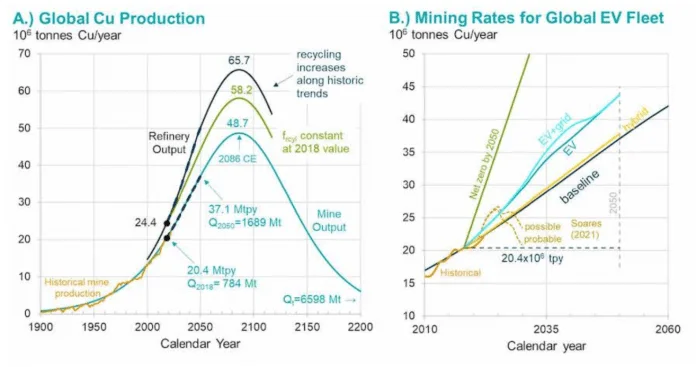 Source: International Energy Forum
Source: International Energy Forum
Phillip Gales:
I saw an IEA article or a piece of research, that was talking about historical and projected recycling rates of various metals. It was saying that around 35 to 40% of all aluminium is recycled these days, but for most other metals the recycling rate is shockingly low
Scott Vincent:
Yeah! Just to add to your point, we will make improvements, because a lot of money is going to go into research around recycling. Recycling and recycling rates will improve. However, if you look at IEA, World Bank and energy analyst reports, you'll see that they all assume that we make massive strides in the ability to recycle some of these more valuable minerals.
But even so, we're still going to require a lot of primary mineral production, which means mining. As you point out, recycling is not the silver bullet right. It requires a lot of energy. It often puts out some pretty nasty emissions. It can be very costly.
Recycling has its place, and the reality is that it can help moderate the demand growth to a certain extent, but it can't do away with the base level of demand that society has for these minerals.
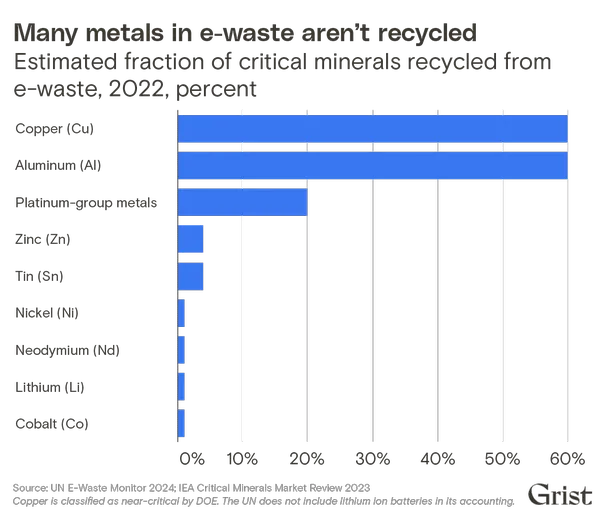
Phillip Gales:
The IEA Supply and Demand projections for cobalt and copper are shocking because there's just enormous gaps between Supply and Demand even in the lowest demand scenarios.
Maybe this is a good point to talk about those critical minerals and what we need them for both in terms of decarbonization and in terms of just general usage.
Scott Vincent:
As you know, minerals go into just about every non-food item out there. The main critical minerals that you find in polymetallic nodules are nickel, cobalt, manganese, copper, and Rare Earth minerals. They have a lot of applications in the energy markets.
For example, Manganese, Nickel and Cobalt go into the cathode for batteries, and they're important because batteries that use those minerals tend to be high energy density batteries. High energy density batteries matter because you want an electric vehicle to go further between charges. If you want people to use electric cars, across most segments of the population, then you need a really energy dense battery. So you need those minerals, in order to make the energy transition more palatable to a large portion of the population.
There are people that argue that we can get there with iron phosphate batteries or sodium ion batteries, and those chemical formulations are going to be important. They're going to play a role. But they're just not going to be able do it all because they don't have the same energy density that nickel, cobalt and manganese batteries achieve.
In addition to Nickel, Cobalt and Manganese, Rare Earths Elements provide materials for magnets that go into electric motors, and Copper goes into just about everything that is energy related because of its conductivity. These are really, really crucial metals, and whether we want to make the energy transition happen or not, these metals are going to be in demand.
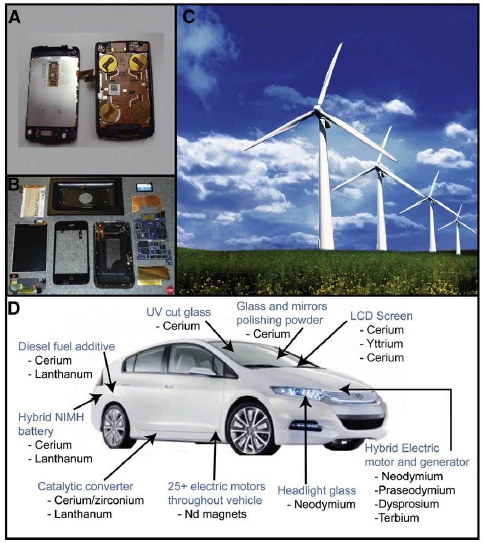 Source: "Deep-ocean mineral deposits as a source of critical metals for high- and green-technology applications: Comparison with land-based resources", Hein et al., 2012
Source: "Deep-ocean mineral deposits as a source of critical metals for high- and green-technology applications: Comparison with land-based resources", Hein et al., 2012
Phillip Gales:
We've had demand for these metals for decades, but it's ramping up a lot with things like electric vehicles, solar power, wind generation, and just the amount of computers and phones that everyone has. Can you talk about how we've met that demand so far from terrestrial mining?
Scott Vincent:
Well, of course, the industrialized world has really outsourced mining to the global south, so that mining typically is happening in tropical rainforests throughout the global South. And as one study has noted, greater than 50% of those mines overlapped with indigenous populations.
"typically mining is happening in tropical rainforests throughout the global South"
So Westerners, who are relatively wealthy are saying, “we don't want the impacts of this mining near us. We'll take those minerals from other places”. But those other places happen to be these areas that are very, very sensitive ecosystems, with human populations adjacent, or on top of them.
Phillip Gales:
So hang on, hang on! Can I stop you there? Because this is really interesting!
When I think about Europe and mining, think about Welsh coal mines, Germany's Ruhr Valley producing iron, and I think about Poland mining Copper.
But what you're saying is that the global North has shut down a lot of those mining projects, and the result is that less economically developed countries (often in equatorial regions and the global South) have stepped up and are mining increasingly large areas.
Scott Vincent:
Right. A lot of these energy minerals are coming from places like Africa, South America, and Southeast Asia. Southeast Asia has been particularly productive in producing these energy minerals, but they often come from areas where you have indigenous populations.
The important thing to note here is that indigenous populations generally sustain themselves from the land and the water and the resources that exist around them. They don't go to the supermarket to get their food. They fish out of the river. They hunt it in those lands. And so these mines are really impacting these indigenous populations in a way that we can't really appreciate. So you get a lot of people who get sick or worse because of these mines located right next door to them.
"indigenous populations generally live on the land and the water and the resources that exist around them"
These mines are often powered by coal power plants as well, so the air quality deteriorates quite a bit. The water quality deteriorates and the impacts spread over wide areas.
Phillip Gales:
Can you speak a little bit more to those impacts?
Scott Vincent:
Sure. So there are a lot of articles out there written about the impacts of Nickel mines in Indonesia. I encourage people to read those articles, because the impacts can displace humans from the lands that they've traditionally used, often without free prior and informed consent (FPIC, as they say). So these lands are often just taken from people. The government is either not really paying attention, or worse, has been bought.
So people are displaced from these lands, and then, the lands are spoiled. The lands are dug up and they're of no use to the people anymore. The rivers are polluted, so where they used to drink from that water and fish in the water and swim in the water, they can no longer do that. The people end up with respiratory and neurological diseases from the emissions that are put into the air from these big coal fired plants that exist in these areas.
One of the biggest problems, that's not much talked about, is the amount of toxic waste that is generated by these processing plants. One of the issues with terrestrial mining is that when your ore grade is around 1%, that means 99% of what you're processing is going to turn into waste. So there's these massive quantities of waste that must be dealt with from those operations.
In places like Indonesia, they don't know what to do with that waste. At first they were dumping it into the ocean, and people were up in arms about that. So they stopped doing that. Now they're drying it and stacking it behind tailings dams. But engineers have done a lot of work looking into the impacts of that, and they're concerned because there's so much rain in the region and so much seismicity, that those dry stack tailings are bound to collapse and hurt people in the future when you have a seismic event or a torrential downpour. So it's a really dangerous situation.
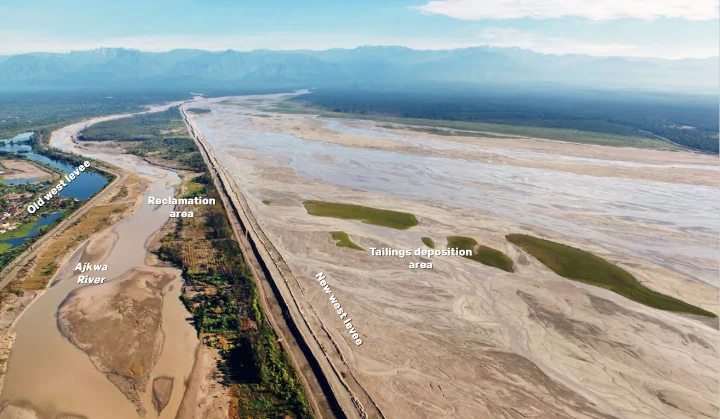 Aerial photo of tailings dam at Grasberg mine in Indonesia. Source: Bloomberg
Aerial photo of tailings dam at Grasberg mine in Indonesia. Source: Bloomberg
People don't focus too much on the issues of waste in terrestrial mining, but just about all of that is avoided if we take nodules from the bottom of the ocean because there is no solid waste with nodules, and we can process them anywhere. We don't have to process them in Indonesia, where they use coal power plants. We could go somewhere where there's clean energy from hydro, from nuclear, or from other sources. So deep-sea mining solves for a lot of problems.
Phillip Gales:
There's this current hypocrisy, then, of a global North pushing for decarbonization, pushing for more wind, solar batteries, electric vehicles, etc. But in doing that is creating enormous demand for those critical minerals which is then pushing for countries like Indonesia to meet that supply. In doing so Indonesia is doing untold damage to their environment, to their society, and to their way of living in order to meet this rapacious Northern demand.
And then many Northern countries are saying that they do not want deep-sea mining because they're concerned about the impacts. Isn't that hypocritical?
Scott Vincent:
It's a great point, right? It's self-defeating, really, honestly.
It calls into question the entire green energy transition, and it reduces the credibility of the transition. It creates an opening for opponents of the transition to say “what the hell are we doing?!?!!?”
Phillip Gales:
Oh. It creates a way in which those that do not want to see this transition can push back on the impacts because it's creating massive negative impacts elsewhere.
Maybe, should we flip into a more positive thing? What do you see as the benefits of that, then, compared to terrestrial mining?
Scott Vincent:
Sure. First of all, just as a little background, my group has looked at deep-sea mineral extraction for over a decade, and we've looked at a lot of different potential operations and geologies, before arriving at polymetallic nodules as a solution.
There are big differences between the different geologies and different resources on the bottom of the ocean, in terms of the ecosystem around those resources, and also the impacts from extraction of those resources.
We believe that polymetallic nodules are the best resource because they're typically located in areas of relatively low biodensity and biodiversity. At the same time, the nodules can be extracted in a non-invasive fashion. So we're doing limited amounts of damage to an area of the ocean that is very remote and hosts relatively small amounts of life.
I qualify that by saying that this is relative to the terrestrial alternatives which are often tropical rainforests, where you have massive biodiversity and massive biodensity in those locations.
Phillip Gales:
I just want to add a very important point, because you've mentioned the low impact of polymetallic nodule harvesting. I think it's really important to point out that what Scott is talking about with harvesting polymetallic nodules is picking up these potato-sized blobs which literally sit on the seafloor. This is not mining in terms of demolition, crushing, grinding, or explosions. This is much, much closer to potato harvesting.
Scott Vincent:
It is. And you know there's a lot of misinformation that's propagated by environmental groups about this in an effort to paint all of these resources with the same bad brush. They show the pictures of equipment that would be used to extract massive sulfides, and those are some scary looking machines. They've got rotating heads with big teeth. They're massive cutting machines.
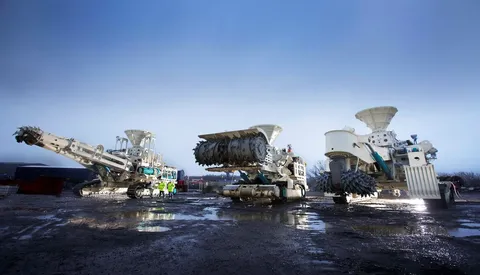 Defunct mining equipment that was developed for extracting seafloor massive sulphides at Solwara-1 in Papua New Guinea, which are often misrepresented by environmental groups
Defunct mining equipment that was developed for extracting seafloor massive sulphides at Solwara-1 in Papua New Guinea, which are often misrepresented by environmental groups
That's nothing like what these harvesters look like. These harvesters are basically large vacuum-cleaners that will be very light at the ocean bottom. Most people don't realize that they have a very light touch (on the seabed) because of their buoyancy in the water. And they're less invasive in the way they pick up these nodules because they shoot a jet of water that goes over the nodules and creates a pressure differential to lift the nodules out of the sediment as the harvester comes past. It is actually a non-invasive extraction process. So it's a totally different proposition than terrestrial mining where you blast and cut and drill deep into the earth's surface, and you create a lot of emissions and a lot of waste in the process.
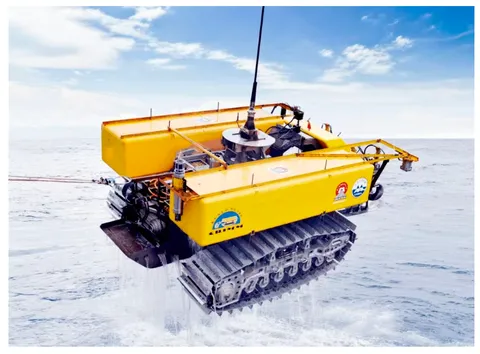 Modern “Kun Long 500” harvester developed in China and used to collecting polymetallic nodules
Modern “Kun Long 500” harvester developed in China and used to collecting polymetallic nodules
Phillip Gales:
Totally agreed. I believe one of the Chinese companies is working on a harvester that's neutrally buoyant. It simply floats. So the actual impact there is really low as this thing comes along and just sucks up nodules.
Scott Vincent:
That's right. I mean, we need to be careful - the impacts are relatively low as we compare them with what happens in the terrestrial sphere. But there are impacts. We will be removing nodules, so organisms that are hosted on those nodules will not be there any longer.
There's the opportunity to leave behind 20-30% of the nodules, so that really helps with recolonization, but we do have to acknowledge that there is damage when we do this.
These processes also create sediment plumes, but those sediment plumes don't travel very far. They stay very localized, and the science has shown that the impact from the plumes is not very significant. Luckily the biodensity and biodiversity doesn't seem to be very impacted at all by those plumes at the bottom water level.
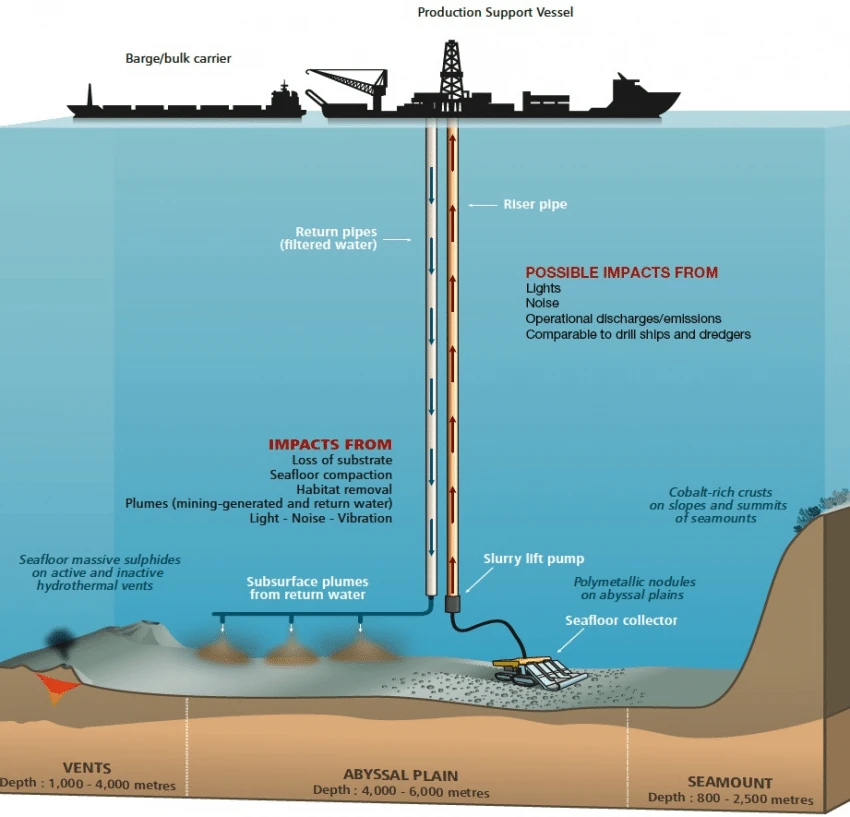 How deep-sea mining for polymetallic nodules works
How deep-sea mining for polymetallic nodules works
It's a little bit more controversial when we talk about the plumes that are created in the water column itself - the midwater or return plume. Some contractors will be using riser pipes to bring up nodules, and they'll have to return sediment through a return pipe, with that sediment being released somewhere between 2,000 meters depth to the very bottom of the abyssal plains (around 5-6000m). Fortunately the studies that have been done so far on those midwater plumes show that they're diluted very, very quickly within several kilometres of being released, and the sediment that comes down onto the abyssal plains from that release is at a level, that is around 1% of the background sedimentation rate, so it shouldn't have an impact on life on the abyssal plains.
There's debate about how much impact it might have with pelagic species, but those species are known to inhabit depths from the surface down to around 1000m, so as long as we release that sediment deep enough, it really shouldn't impact those pelagic species.
Phillip Gales:
Scott, can you tell us more about the arguments that are used in opposition to deep-sea mining?
Scott Vincent:
One of the things that opponents say is that by bringing up minerals from the bottom of the ocean we will not reduce terrestrial mining. So there are 2 scenarios to examine when we look at this issue:
One scenario is low demand growth in critical minerals. We see an example of this today in the Nickel mining industry, where we're bringing on a lot of low cost supply from Indonesia, and that is displacing supply from Australia and the Philippines and elsewhere. When you bring on new supply, you are absolutely displacing existing supply and closing down that supply because you cause the commodity price to decline. So the idea that deep-sea mining wouldn't reduce the amount of harmful or impactful operations is contrary to what we're seeing in the marketplace today.
The other scenario is in a high demand growth scenario, where if we bring more supply into that market, you might not see the same price response because supply is only meeting demand. The market clearing price might not go down sufficiently to close mines, but in that case, deep-sea mining would reduce the need to expand existing terrestrial mines in tropical rainforests, or open new mines in tropical rainforests.
So in either demand environment; low growth, or in a high growth market, we absolutely do reduce the need to tax these highly sensitive ecosystems and harm people by bringing nodules to the market. So that's an important misconception out there.
Another misconception is that the abyssal plains have astounding biodiversity. I think that this storyline got out there, because at one point there was prevalent thought that there was no biodiversity on the bottom of the abyssal plains because of the temperatures, pressure and lack of light resulting in a lack of plant life. But there is biodiversity on the abyssal plains! It's just that the level of biodiversity is orders of magnitude less than what we find in many of the terrestrial locations where we're mining the same metals today.
For instance, tropical rainforests are thought to hold around 4.4 million species, and around 86% of those species have yet to be identified. By contrast, on the abyssal plains within the Clarion-Clipperton Zone, it's estimated that there are around 8,000 species, and the majority of the biodiversity that exists on the abyssal plains is generally microscopic.
We don't know what we're destroying when we mine in those terrestrial rainforest locations, we don't know what the ranges of many of those organisms are, and we don't know how many extinctions we're driving when we mine in those rainforest locations. These are precisely the arguments that environmentalists make against nodule harvesting. But clearly there is much more at stake when it comes to terrestrial mining - both because there is much more biodiversity at risk and because we are doing much more damage in a given area. Nodule harvesting isn't perfect, it's just much better than the alternatives.
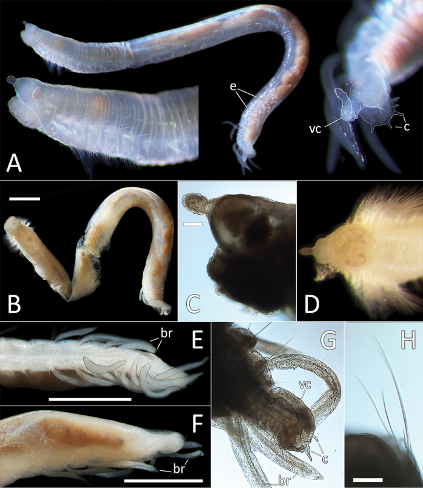 Source: “Abyssal fauna of polymetallic nodule exploration areas, eastern Clarion-Clipperton Zone, central Pacific Ocean”, Wiklund et al
Source: “Abyssal fauna of polymetallic nodule exploration areas, eastern Clarion-Clipperton Zone, central Pacific Ocean”, Wiklund et al
Phillip Gales:
That's a vast difference - 4.4 million versus 8,000 different species! And from my understanding is that the vast majority of the deep-sea species live in the sediment itself and not on nodules.
Scott Vincent:
It is! The differences are massive. And yes, approximately 14% of organisms on the plains live on or rely upon nodules according to a study published last year.
Another point here that people don't talk about enough, and environmentalists generally miss, is that we will impact much less than one percent of the abyssal plains with nodule harvesting over 20 years, but our impacts from terrestrial mining amount to 10-30% of rainforest ecosystems according to sources we have seen. Rainforests are endangered and are highly sensitive and we are demolishing them with mining and other human activities. The abyssal plains host much less life and biodiversity, and harvesting nodules disturbs them, it doesn't destroy them.
And arguably the most important species are human beings and while we kill and sicken tens of thousands as a result of terrestrial mining operations, we will do negligible damage to humans when we collect nodules. So, we think the choice is pretty clear. Nodules offer a huge benefit and a huge windfall for society.
Phillip Gales:
So for our last question, Scott, what do you see as the opportunity here for the world, with deep sea mining?
Scott Vincent:
We've tapped the resources on 29% of the world's surface pretty effectively, to the point where the ore grades that we're mining today are significantly lower than decades ago. That means that we're digging up more rock to get less metal. And that trend is going to continue.
If we limit ourselves to only terrestrial resources then grades will continue to decline, meaning that we'll do more and more damage to humanity and to the ecosystems as we go forward and increase our demand.
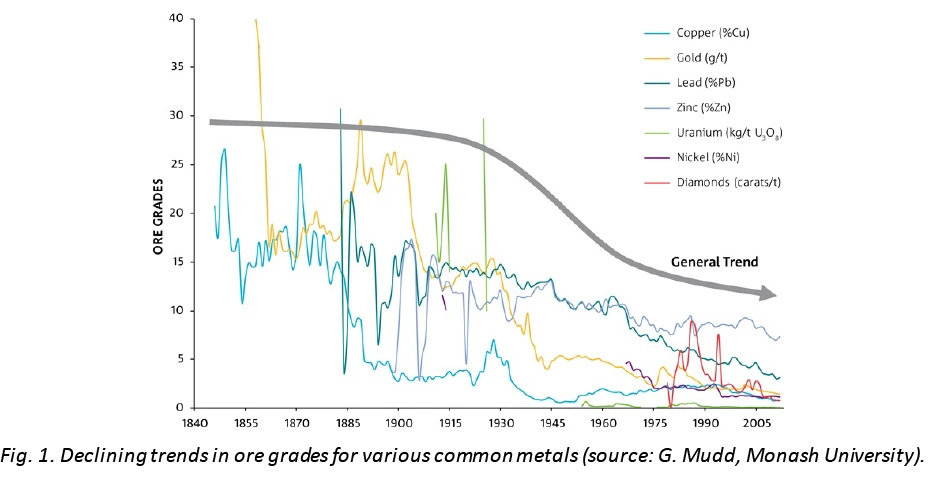
We've got 71% of the earth surface that we have yet to tap at all. And luckily we can tap those resources and get at some very high grade opportunities non-invasively via deep-sea mining. So it's really a gift to the world and a huge win-win opportunity if we can tap those resources going forward.
Deep-sea mining should help us with decarbonization, and help a lot of non-industrialized nations and people that don't benefit from the access to energy the way that you and I do. It could benefit those people a lot if we develop these critical minerals in a much less impactful way than terrestrial minerals.
Phillip Gales:
I think these are just brilliant points you're making, Scott. It's a huge win-win. And we do that by unlocking the 71% of the world that we haven't mined, using technology that is low impact that is not tearing up the rainforest, that is not causing tailings dams, and that is not impacting indigenous or underrepresented peoples. We do it in a far cleaner way in a way that allows us to decarbonize and benefits the world with the critical minerals.